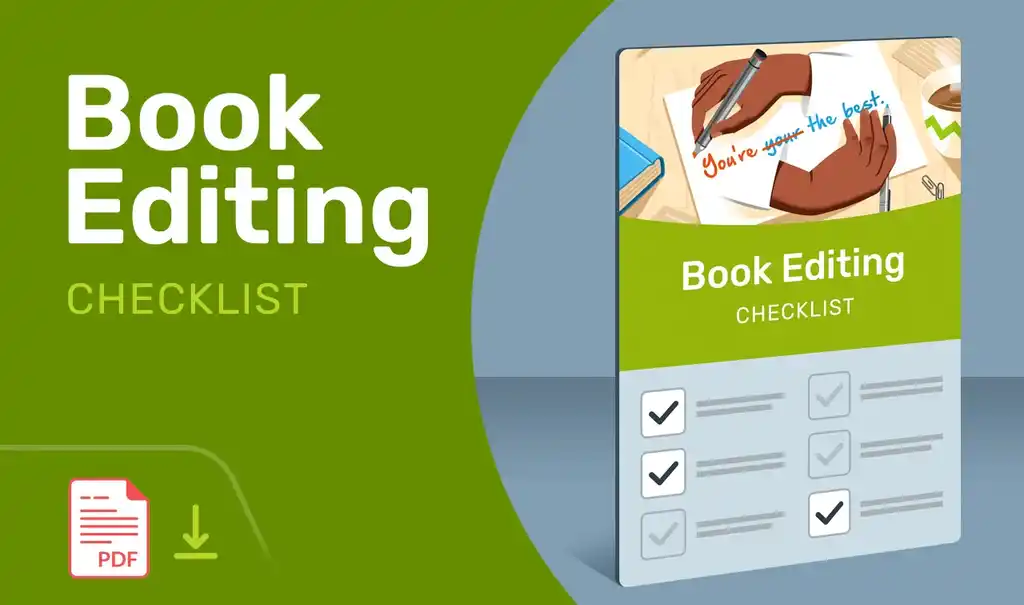Posted on May 10, 2021
Inclusive Language: An Author's Guide (with Examples)
Inclusive language is used whenever anything (books, magazines, films, TV shows) is written to accurately reflect and respect the experiences of specific communities. When writing is not inclusive, it can make people of these groups feel excluded, like the writing isn’t for them — and may even cause them to stop consuming that work entirely.
Imagine you’re a devoted scout leader who’s just picked up a book by your favorite author — a promising thriller titled The Scoutmaster. Though you were excited to read it, you quickly realize the author has gotten a lot wrong: from terminology to the portrayal of the main character, none of it matches up with your experience. You don't see yourself in the writing and it seems that the author doesn’t actually care about scouting or people who scout. In addition, the book is based on stereotypes and assumptions!
In other words: they haven’t written inclusively about scouting.

To clarify, the conversation around inclusive writing focuses on marginalized communities: folks who are sidelined or persecuted in mainstream society and culture, often preceded by a history of oppression. This includes (but is not limited to) BIPOC, LGBTQ+, neurodivergent, and disabled people.
The topic of inclusive writing is sticky and complex, but in this post, we’ll try to take a nuanced look at some of the less-than-inclusive terms and writing habits that authors may have acquired over the years — and provide some simple tweaks that can help you welcome a wider range of readers into the wonderful world of your writing.
Note that this article will contain some stereotypes, slurs, and derogatory terms to provide context on how language usage has changed over time.
Why is writing with inclusive language important?
Historically speaking, it’s been easy for certain terms and ideas to become ingrained that seem innocuous but are actually insensitive or offensive to these marginalized groups. These elements have been able to embed themselves into our language largely because the groups in question have traditionally had little power.
A big part of inclusive writing is simply being conscious of such outdated terms and avoiding them (which is why we’ll go over some of the most common problem phrases below!). However, truly inclusive writing should go even deeper than this, also considering the less obvious, more implicit boundaries between groups other than outright slurs and stereotypes. For example, using words like “we” and “our” in one’s writing is sometimes necessary and often harmless, but not all readers will have the same experience and, depending on the context, might feel unacknowledged or misunderstood when authors write “we” without reflecting on who's part of that imagined group.
Essentially, the mission of inclusive writing is to a) identify where one’s natural writing style inadvertently includes offensive terms, perpetuates stereotypes, and generally “others” potential readers — and then b) work to eliminate these issues. Once an author understands this, they can use their creativity and craft to write with much greater intention and openness.
Inclusive writing in nonfiction and fiction
Before outlining some of the specific areas and elements of inclusive language, it’s worth noting that different forms of writing require different forms of inclusivity.
Various types of nonfiction like journalism, academic writing, legal texts, and company policy guides tend to be written in an “objective” style — they’re usually seen as factual and unbiased. As a result, there’s a greater onus on the writer to be accurate and fairly neutral. Using terms that are incorrect or might alienate the people they’re writing about will not only insult those groups but undermine the argument the writer is trying to make.

Fortunately, as nonfiction deals with real-life people, publishers can ensure that the texts they publish are not damaging or offensive by consulting with individual people about the terminology they prefer, and how they would describe themselves. Authors who self-publish nonfiction can, of course, do the same with a little initiative.
Inclusive fiction writing is somewhat less straightforward. After all, fictional characters might be made up, but they can (and should) still reflect the people around us — warts and all. At times, this will include characters who are themselves biased against other groups.
Suppose a fictional character thinks, talks, or behaves offensively. In that case, an author should clearly distinguish between the character’s voice and the author’s voice, to indicate that this is a deliberate choice that the author might then comment on — ideally in a way that shows this character is not meant to be a role model. They may also want to consider whether a character that uses exclusionary language is necessary for the story, or whether they’re only there to add shock value.
Copy editors are trained to flag up potential issues that might arise in your writing and suggest alternatives or point you in the right direction.

Where can you find the best copy editors and proofreaders?
They're right here on Reedsy! Sign up today and work with them on your next book.
Learn how Reedsy can help you craft a beautiful book.
And, when in doubt, you can also turn to sensitivity readers who are part of the community you’re writing about, so they can evaluate your work for cultural blind spots and give you feedback on what to adjust before you publish. Check out that post to learn more!
So what does inclusive and non-inclusive writing look like in practice? Though inclusive language decisions should almost always be made on a case-by-case basis, here are a few guiding principles that authors can refer back to.
Ethnicity, race, and nationality
Though we probably all know not to use slurs and over-the-top stereotypes in our writing, there are other issues that can still crop up. For example, every good writer knows that specific details bring a scene to life — it’s part of the show, don’t tell ethos to storytelling. But occasionally, overly specific descriptions of people may verge on harmful stereotypes. For example:
As Mark pulled himself from the wreckage, a group of Japanese tourists began to gather in fascination.
While it’s true that the “Japanese” descriptor helps the reader imagine what the tourists look like, this mental image will likely be influenced by the tired, regressive stereotypes of Asian tourists usually portrayed in popular culture. Here’s another version of that sentence:
As Mark pulled himself from the wreckage, a group of tourists began to gather, snapping selfies in front of the chaos.
This alternative achieves what the author intended — the intrusive presence of tourists — with a potentially stronger image, without the use of questionable modifiers. Writers intent on being more inclusive should always question whether referring to someone’s ethnicity, race and/or nationality is actually relevant to the context.
That said, authors should avoid colorblind language which completely eliminates race and ethnicity from the equation when it actually is relevant. For example, if an American driver is being pulled over by the police, the fact that they are Black would be hugely relevant.
Understanding the difference between ethnicity, race, and nationality
When referring to ethnicity, race, and/or nationality, it’s important not to conflate the three. Though definitions may vary, according to the U.S. Census Bureau:
- Race is mainly a social definition that refers to a person’s self-identification with a group;
- Ethnicity refers to someone’s cultural background or place of origin;
- And nationality is based on international law and refers to someone’s legal identification as a subject of a nation.
There is no scientific basis for race, but race is more often connected to physical traits and appearance, while ethnicity may be selectively displayed. Authors sometimes prefer using ‘ethnicity’ as a term, as it can be perceived as more neutral than ‘race’. That said, though the two terms do overlap, authors should always attempt to use specific language when required, as the conflation of these terms can lead to both mistaken and harmful representation.
For instance, not all Black people in America identify as African American. On the flip side, many prefer the term African American over Black. In addition, describing all Black people as African American (when they may in fact be German or French nationals) is reductive, to say the least. In these cases, specificity based on personal preference (and accuracy, of course, as in this case of ethnicity vs. nationality) is always advised.
Black with big or small ‘B’?
On the topic of capitalization, many have advocated for a capital B in the word ‘Black’ when it is used to denote race, ethnicity, or cultural background. The recent surge of Black Lives Matter protests and activism saw the Associated Press (AP) adopt capitalization, stating that “The lowercase black is a color, not a person.” In the same article, AP announced that references to Indigenous communities would also be capitalized (Native American, Indigenous Canadian, Aboriginal Australian).
‘White’, on the other hand, is not commonly capitalized as it denotes a different set of meanings, usually carrying white supremacist overtones.
Is it Asian-American or Asian American?
When referring to someone with dual heritage as a compound noun, it has been common practice to use a hyphen. AP only recently decided to remove the hyphen in dual heritage terms such as African American, Asian American, and Mexican American. This change has been credited to Henry Furhmann’s article Drop the Hyphen in Asian American.
Fuhrmann outlines how the hyphen can be experienced as more of a divider than a connector for people with dual heritage. It emphasizes that they are American, but only partly, rather than both wholly Asian and wholly American. Hyphens are still widely used in compound adjectives, however:
- Compound noun: “He is Mexican American.”
- Compound adjective: “He is using a Mexican-American phrase.”
Lastly, just as a reminder, slang terms, slurs, and outdated problematic expressions should be avoided at all costs — unless you are part of the group you are referring to or it is being directly interrogated in the writing:
Don’t write |
Write |
|
Oriental |
Asian, or a specific nationality/ethnicity. |
|
Colored person/people or ethnic |
Person/people of color or [specific race/ethnicity/nationality]. |
|
Mixed race |
Dual heritage, multi-racial |
|
Minority (unless referring to a numerical or factual minority) |
Marginalized |
|
Eskimo |
Inuit, Iñupiat, Yupik, or Aleut. |
Gender, sex, and sexuality
Gender-inclusive writing recognizes that gender isn’t synonymous with sex, instead operating on a spectrum, like sexuality does. Since it’s always advised to use accurate terminology and these terms are often conflated, it’s useful to clarify the distinctions among them:

Sex generally refers to someone’s physical characteristics, often assigned at birth and produced by hormones and chromosomes. It typically operates on a male/female binary but also includes people who are intersex or have a difference of sexual development (DSD).
Gender is a social identity and construction based on labels of ‘masculinity’ and ‘femininity’, as well as one’s internal perception of oneself. One may identify as a different gender than was assigned at birth. It generally operates on a spectrum and includes gender identities like man, woman, agender, gender-fluid, and non-binary.
Sexuality refers to someone’s sexual orientation or the romantic attraction between two people.
All this expresses itself differently in fiction and nonfiction and depending on whether you’re referring to a specific person or character, or whether you’re speaking more generally about a person or a group of people.
Gender and sexuality in your narrative
If you’re a fiction author, it’s up to you to decide how your characters identify and consider whether that has an impact on different scenes. In dialogue, for instance, there’s nothing wrong with writing “he said” or “she said”, if that’s how your characters identify.
It’s more important to write in ways that don’t perpetuate stereotypes about gender, sex, and/or sexuality. Again, first and foremost, avoid using shorthand that relies on preconceived notions. Instead of writing “Frankie ran like a girl,” you could better evoke Frankie’s odd running style by comparing it to a clumsy emu chick.
In nonfiction, unless gender, sex, or sexuality are directly relevant factors, authors should try using gender-neutral terminology and expressions (for example, “businessperson” instead of “businessman”). It’s also important to use the correct pronouns, titles, and descriptions.
Non-gendered pronouns
When gender doesn’t add anything to the sentence, is unknown, or you want to construct a general sentence that applies to a group of people, authors can replace pronouns like ‘he’, ‘she’, ‘him, and ‘her’ with a singular or plural ‘they’, or a the singular ‘you’. This addresses all readers of your text, without excluding parts of the population, and is the preferred method of writing over ‘he/her’ or ‘she/him’.
As a simple tweak if you prefer to avoid pronouns completely, many pronouns can easily be removed from sentences by changing the word order:
A student should always try to be as inclusive as possible in his or her writing.
A student should always try to write using inclusive language.
Here are some more ways you can adjust your gendered language to be more inclusive:
Don’t write |
Write |
|
Fireman, Policeman |
Firefighter, police officer |
|
Chairman, chairwoman |
Chair |
|
Actor/actress |
Actor |
|
Mankind |
Humanity, people, human beings |
|
Male nurse, female doctor |
Nurse, doctor |
|
“The best man for the job.” |
“The best person for the job.” |
|
‘Guys’ or other gendered collective phrases to refer to a group of people |
Everyone, folks, people, you all, etc. |
Queer identity labels
In British and American English, ‘LGBT+’, ‘LGBTQIA+’, and ‘Queer community’ are commonly used as umbrella terms. Terms that signify one type of Queer identity cannot replace these umbrella terms. For instance, what is true of ‘the lesbian community’ may not apply to the larger LGBT+ movement. “Queer” itself also has something of a complicated history as a slur, and while most LGBTQ+ communities have reclaimed it and use it commonly, you should definitely ask an individual before describing them as such (if you’re writing nonfiction), or again, consider a sensitivity reader for fiction.
The labels used to describe members of the LGBTQ+ community will vary depending on geography and personal preference, but here are a few crucial distinctions that are worth committing to memory:
Don’t write |
Write |
|
Homosexual |
Gay |
|
Bi-sexual |
Bisexual |
|
Openly gay |
Out |
|
Sexual preference |
Sexual orientation |
|
Biological sex |
Assigned sex |
|
Opposite sex, both sexes |
Other/different sex, all sexes |
|
“... who used to be [gender]” to describe Trans people |
[preferred pronoun] |
Lastly, references to someone’s sexuality should consider the person’s preferences and be made with their consent. Authors should never assume someone’s sexuality, as those assumptions will likely stem from unhelpful stereotypes — and even if an assumption is correct, you could be outing a person who doesn’t wish their personal preferences to be known.
Disability and neurodiversity
Common language usage has not been kind to neurodivergent people and people with disabilities. At the most immediate level, mean-spirited or careless descriptions of these characters commonly crop up in all writing genres. However, negative connotations about disability and neurodiversity have worked their way into everyday vocabulary on a more subtle level. Think of phrases like:
What a lame way to spend a Friday evening;
The company had gotten itself into crippling debt; or
When they heard the news, they went crazy.
This may seem innocent enough to most readers, but can be upsetting to those who regularly experience those labels personally.
Now, suppose you’re writing about or referring to an actual disabled or neurodivergent person, and this is pertinent information. In that case, our main advice is to use a combination of general and specific language, depending on the context and the person’s preferences (if it’s nonfiction) or the preferences of others in that group (if it’s fiction). Let’s expand on that a bit.
Person-first vs identity-first
The debate of ‘person-first language’ vs ‘identity-first language’ goes beyond disability and neurodiversity, as evidenced by the examples above, but is especially relevant here. ‘Person-first language’ is a linguistic construct that places the person before the disability, both figuratively and literally:
Mr. Smith has a lot of experience working with people with autism.
Until recently, this has been the preferred way of referring to neurodivergent people or people with disabilities — particularly in the US. It’s argued to place more emphasis on the person, and to highlight that their disability or neurodiversity is only part of their identity.
In the UK, however, ‘identity-first language’ is more frequently used and disability activists in the US have started to advocate for this form, arguing that their disability is an inseparable part of their identity, preferring expressions like:
Mr. Smith has a lot of experience working with autistic people.
This debate about person- vs identity-first language shows the need for authors to treat each case with the care and attention it deserves. Not only are there regional differences, but different communities and individuals will have different preferences. Identity-first language, for instance, is particularly accepted in Deaf communities and the autistic rights community in the US.
Where possible, it’s always best to check with the person concerned or to verify their preferences via their public information. You can also turn to established organizations to determine the prevailing language practices in your country of publication, relevant contextual aspects such as the type of disability or neurodiversity, and how your writing is framed.
Lastly, regardless of whether you choose to use person- or identity-first language, you can easily replace certain expression to make your writing more inviting to all readers:
Don’t write |
Write |
|
Monoliths like “the disabled” or “the blind”. |
“People with disabilities/disabled people” or “people with visual impairment/blind people”. |
|
Medical labels and markers which reinforce the idea of people with disabilities as “patients” or “unwell”. |
Expressions that use person- or identity-first language instead. |
|
Negative and victimizing phrases like “suffers from [disability]” or “confined to a wheelchair”. |
“Has [condition/name of diagnosis]” or “is a wheelchair user/uses a wheelchair”. |
|
Lazy vernacular expressions like “crazy” or “psycho” as descriptors. |
Something more specific like “wild”, “unpredictable” or “chaotic” instead, depending on what you want to describe. |
|
Subtly ableist language like “lame” or “crippling” in a negative context. |
Again, more specific language to express what you really mean — for example “What a boring way to spend a Friday night” or “the company had gone into a great deal of debt” |
Additional resources
Writers can implement inclusive language directly in their writing, but a good reader who can beta read or copy editor can also help them catch things they might have missed or simply not thought about. If you’re writing about a marginalized community you don’t belong to, think seriously about hiring a professional editor to ensure you’ve handled it sensitively.
Finally, note that there are several other aspects of inclusive writing, such as age, class, and religion. So in addition to following the tips in this article, getting an editor, and keeping your references current through social media and following the news, you may also want to save these links for future reference.
- Conscious Style Guide: A thorough hub of resources and articles on inclusive (or conscious) language.
- Diversity Style Guide: A searchable guide with over 700 terms related to race/ethnicity, disability, immigration, sexuality and gender identity, drugs and alcohol, and geography.
- 18F Content Guide on Inclusive Language: A US Government style guide for inclusive language.
- The NLGJA: The Association of LGBTQ Journalists Stylebook: A stylebook focused on Lesbian, Gay, Bisexual, Transgender, and Queer terminology (also available in Spanish).
- GLAAD Media Reference Guide: A reference guide for “journalists reporting for mainstream media outlets and by creators in entertainment media who want to tell LGBTQ people's stories fairly and accurately.”







